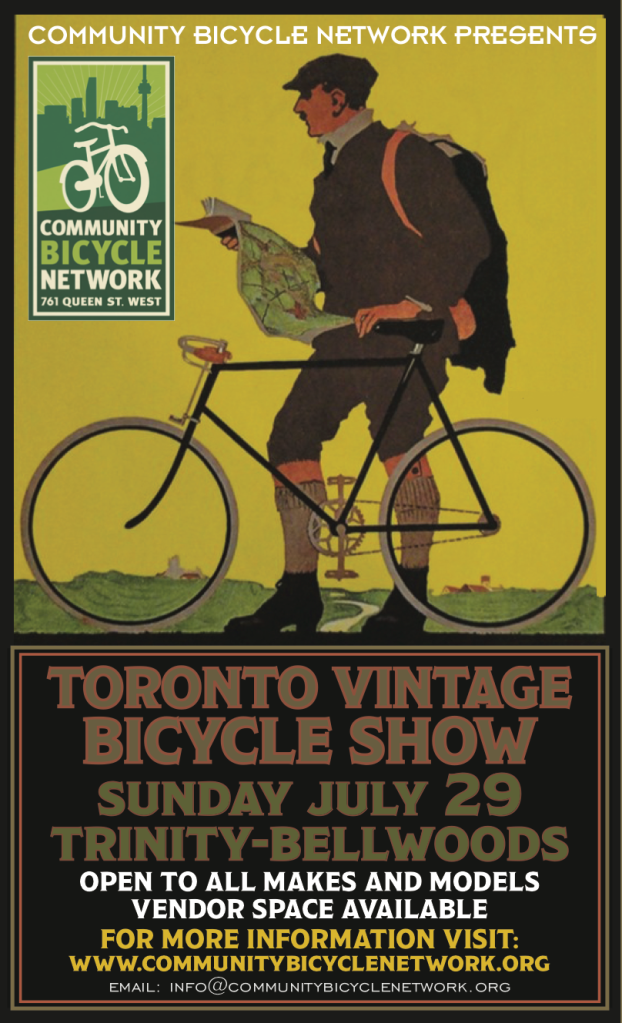Archives
How about some snow tires for the baby carriage?

Or some fancy blades for the feet?






 The first hockey sticks were carved by Mi'kmaq natives of Nova Scotia. They used a wood called hornbeam, also known as ironwood because it is so strong. The best trees for making sticks had roots that grew out in the correct angle for a stick blade. When the hornbeam was used up, the carvers turned to yellow birch, another hard wood. The early sticks looked more like today's field-hockey sticks, with a blade that curved up. They were also shorter and heavier. As hockey grew in popularity, the Native carvers could not make the sticks fast enough for everyone who wanted one. The Starr Manufacturing Company of Dartmouth, Nova Scotia, began making hockey sticks. They called their sticks Mic Mac, after the original makers. These sticks were popular in the 1930s.
The first hockey sticks were carved by Mi'kmaq natives of Nova Scotia. They used a wood called hornbeam, also known as ironwood because it is so strong. The best trees for making sticks had roots that grew out in the correct angle for a stick blade. When the hornbeam was used up, the carvers turned to yellow birch, another hard wood. The early sticks looked more like today's field-hockey sticks, with a blade that curved up. They were also shorter and heavier. As hockey grew in popularity, the Native carvers could not make the sticks fast enough for everyone who wanted one. The Starr Manufacturing Company of Dartmouth, Nova Scotia, began making hockey sticks. They called their sticks Mic Mac, after the original makers. These sticks were popular in the 1930s. 
The first recorded production of hockey sticks in Canada was carried out by the Mi'kmaq natives of Nova Scotia, who carved them out of a wood called hornbeam, also known as ironwood because of its strength. When the hornbeam was used up, the carvers turned to yellow birch. The early sticks looked like field-hockey sticks with a blade that curved up. They were shorter and heavier than the sticks that came to be used in later years.
As hockey grew in popularity, the Native carvers couldn't keep up with the demand. As a result, the Starr Manufacturing Company of Dartmouth, Nova Scotia, began manufacturing hockey sticks and calling them Mic Macs in honour of the original makers.
Having distributed sticks and other hockey equipment for various companies over the years, in 1933 Canada Cycle & Motor acquired an interest in the Jos. Choquette Wood Specialties Co. Ltd. of St. Jean, Quebec. The Quebec company had been founded in 1919 by brothers Joe and Ed Choquette, who started out making hockey sticks in the rear of their sporting goods store on City Hall Avenue in Montreal before moving production to the factory in St. Jean.



Three different views of the Choquette factory in St. Jean, Quebec
According to the Choquette brothers for a hockey stick (usually elm or ash) to be strong, the wood had to be light, straight and have few marks on it. On one occasion to demonstrate the truth of the claim, Ed Choquette stepped up to the huge rack of sticks in the Choquette store and selected a stick. He then placed one end of the stick on the floor and the other against the rack and jumped on it. While Ed was tossed unceremoniously into the air, the stick stayed in one piece prompting Ed to exclaim: “Now there's a stick you can play hockey with!” (1)

Top left: Five acres of ground piled with choice hand-picked logs to be sawed under the personal supervision of Jos. Choquette.
Top right: Standing is Mr. Ernie Everden, inventor of the C.C.M. laminated model. Sitting is W. Prince also of the factory staff. Both on a tour of inspection.
Bottom left: Mr. J. Howes C.C.M. Ontario sales manager and Mr. C. Lawrence convincing themselves that 12 lbs. of green lumber is used in the making of every C.C.M. hockey stick.
Centre: Note there are no logs of large diameter in this lot. Only second growth small trees are selected. Handle stock for the top three grades of C.C.M. Laminated Ice Hockey Sticks is taken from logs 6” to 9” diameter.
Bottom right: Mr. J.A. Russell and Mr. N.P. Tonkin seen standing between two rows of logs piled shoulder high. Note again uniform size of logs selected for the manufacture of C.C.M. Ice Hockey Sticks.
(From: 1935 CCM Sporting Goods Catalogue)

The first CCM laminated hockey stick was developed by company employee Ernie Everden and left the St. Jean factory in 1935. While early sticks had been made of a single piece of wood with the curve at the bottom created by using steam to cure and bend it, the laminated stick was made of various layers held together by waterproof glue. Everden sought and was granted a patent for a three-piece stick where the shaft and blade are separate, held together by a wooden wedge and glue. Not only was the laminate stick easier to make, there was less waste.
“We can use a lot of lumber in making these that would otherwise have to be scrapped. You see, it’s much easier by this process to make sure that both the blade and the handle are straight-grained and that a light stick will stand up in play,” explained Ed Choquette. (2)

The great Rocket Richard picks a stick from a pile of CCM lumber.
 As time went on, players in the NHL began to ask for lighter sticks. While the standard weight for a stick had been 26 ounces, players looked for sticks that were as light as 17 or 18 ounces. It was a request that didn't sit well with team owners, who were now being forced to pay for an increasing number of broken sticks. Among them was Conn Smythe, the frugal owner of the Maple Leafs, who demanded his players use 25 ounce sticks no matter what their preference.
As time went on, players in the NHL began to ask for lighter sticks. While the standard weight for a stick had been 26 ounces, players looked for sticks that were as light as 17 or 18 ounces. It was a request that didn't sit well with team owners, who were now being forced to pay for an increasing number of broken sticks. Among them was Conn Smythe, the frugal owner of the Maple Leafs, who demanded his players use 25 ounce sticks no matter what their preference.
While hockey sticks were generally made to a club’s guidelines, there were a few players who could ask that their sticks be made to their own specifications. It was a practice that never found favour with CCM for it usually left the company holding a number of unwanted sticks. A player, having had the company make twelve different styles of sticks, then picked one leaving CCM holding eleven. Often the left-over sticks found their way, as “autographed models,” to be sold in Doug Laurie’s sports shop at Maple Leaf Gardens.
By 1940 the Jos. Choquette Wood Specialties Co. Ltd. was a wholly-owned CCM subsidiary known as Cho-Wood Products Ltd. By this time the company was producing 240,000 hockey sticks annually, including 125 different custom-made models for NHL players. In 1946 the company suffered the loss of Joe Choquette who died in a Montreal automobile accident. An avid amateur baseball player, in his early days Choquette had played on a ball team with Howie Morenz and Odie Cleghorn. At the height of the Canadien-Maroon rivalry, when players didn't mingle much, it wasn't uncommon to see the likes of Nels Stewart, Hooley Smith and Howie Morenz together at the same time looking for a hockey stick. It was said that when the players visited Joe Choquette, “they met on common ground.”

For many years the CCM sporting goods line was overseen by George Parsons (1914 – 1998), a former member of the Maple Leafs, who had played in two Memorial Cup tourneys before turning pro in 1935. Parson’s playing career was cut short in a game against the Chicago Blackhawks on Mar. 3, 1939, when the blade of a stick accidentally clipped his left eye cutting the retina and causing him to lose sight in that eye. Denied permission to continue playing, Parsons became a fulltime employee of CCM and eventually its Vice-President in Charge of Product Development.

It was Parsons who oversaw the development of the CCM AcuFlex hockey stick, designed to match the strength of the player with the strength of the stick. Stronger players, according to Parsons, needed a stiffer stick. With each of the AcuFlex sticks marked with bright colour bands, dealers were given a device known as a “Dynamometer”. Developed in conjunction with Dalhousie University in Halifax, the "Dynamometer" was used to measure the strength of the athlete’s grip. Once the appropriate colour was determined based on where the needle of the dynamometer pointed when gripped by the player, the dealer was then able to select the appropriate stick with the matching colour band.

One of the most colourful sticks produced by CCM was for American daredevil Evel Knievel. An avid hockey player, who once played with the Charlotte Clippers of the Eastern Hockey League, Knievel was hired by Toronto Toros' owner John Bassett to take four penalty shots on team goaltender Les Binkley between periods of a WHA game on April 11, 1975. To accomplish the task Knievel was given a CCM stick decked out in his signature red, white and blue colours. With Frank Gifford on hand to cover the event for ABC’s Wide World of Sports, Knievel used the stick to score twice, earning himself $20,000. Meanwhile Binkley used the $2,000 given him for his two saves to take his teammates out for dinner and drinks after the game.
Unfortunately, time and neglect would eventually catch up to the CCM sporting goods factory in St. Jean, Quebec, just as they would to the company's bicycle plant in Weston, Ontario. In November 1982 when Cooper Canada Ltd. was considering making an offer for the St. Jean plant, they a sent a couple of company representatives out to take a look at the operation. What they saw didn't impress them.
TWhen Henry Nolting and Jerry Harder of Cooper Canada Ltd., visited the St. Jean plant, they found only a hundred or so workers still there, most of whom were said to be apathetic and listless. The research and development department (two people) was said to be experiencing problems with their Propacs (CCM’s version of the Cooperall) and working with the Quebec Nordiques to improve the product.
The factory itself was in no better shape. The roof in the stick-making section was leaking; the offices were said to be in a mess and the warehouse was full of old stock. The boot-making operation had fared a little better, according to Harder, and could be transferred to Cooper Canada Ltd.’s Toronto location. In the end, Nolting and Harder determined the assets of the operation were certainly worth no more than “book value” and even that was a stretch. (3) It was a sad end to what had once been a glorious enterprise.
1. "Modern Plant Turns Out 240,000 Hockey Sticks For Twenty-Four Countries," VIM, Vol. 22, No. 2, 1935
2. ibid.
3. Donald H. Thain, "Cooper Canada Ltd.," London: Ivey Publishing, 1983
TttyyyyyyyyTtttthhh
Top left: Five acres of ground piled with choice hand-picked logs – 110M feet at this one mill for sawing under the personal supervision of Jos. Choquette.
Top right: Standing is seen Mr. Ernie Everden, inventor of the CCM laminated model. Sitting is W. Prince also of the factory staff. Both on a tour of inspection.
Bottom left: Mr. J. Howes CCM Ontario sales manager and Mr. C. Lawrence just convincing themselves that 12 lbs. of green lumber is used in the making of every CCM hockey stick.
Centre: Note there are no logs of large diameter in this lot. Only second growth small trees are selected. Handle stock for the top three grades of CCM Laminated Ice Hockey Sticks is taken from logs 6” to 9” diameter.
Bottom right: Mr. J.A. Russell and Mr. N.P. Tonkin seen standing between two rows of logs pilrd shoulder high. Note again uniform size of logs selected for the manufacture of CCM Ice Hockey Sticks.
the
wwww
aaaaaaaaaa

It was in September 1899 that Walter Massey, in an attempt to strengthen his family’s position as Canada’s largest bicycle maker, amalgamated his bicycle works with that of the Welland Vale Manufacturing Co. of St. Catharines, the Goold Bicycle Co. of Brantford and the H.A. Lozier & Co. and the Gendron Mfg. Co., both of Toronto, to form what Massey and his partners called Canada Cycle & Motor Co. Ltd. (CCM).
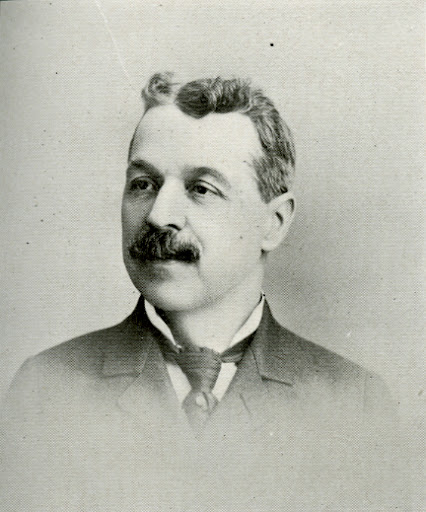 Based in Toledo, Ohio, the Gendron Mfg. Co. had been established by Peter Gendron (1844 - 1911) who, in 1865, at the age of 21, had left his father’s wagon works in St. Ours, Quebec, to move to Ohio where he found employment as a pattern maker for the Toledo Novelty Works. By 1871 Gendron had established his own business.
Based in Toledo, Ohio, the Gendron Mfg. Co. had been established by Peter Gendron (1844 - 1911) who, in 1865, at the age of 21, had left his father’s wagon works in St. Ours, Quebec, to move to Ohio where he found employment as a pattern maker for the Toledo Novelty Works. By 1871 Gendron had established his own business.
In 1874 the ingenious young French-Canadian was granted a patent for a lightweight, wire-spoke wheel he had designed. The wheel was quickly found to be more durable and much superior to the heavy, solid wooden wheels of the time. Gendron incorporated ball bearings into the hub to reduce the wear on the wheel as it turned on the axle and in 1880 established the Gendron Wheel Co. to install his invention on everything from baby buggies and doll carriages to wagons and wheelchairs. The first vehicles to use the new Gendron wheel were the large adult tricycles of the 1800’s.

In 1895 Gendron established the Gendron Mfg. Co. of Toronto and built an impressive brick factory at 411 Richmond St. in Toronto. Here his company began to produce not only bicycles and tricycles, but doll carriages and other children's toys as well.

Producing bicycles under the brand names of Gendron and Reliance, the Gendron Mfg. Co. claimed their bicycles were the fastest in the country. It was a feat, they said, made possible by the use of a three-point bearing in its wheels and a fact clearly demonstrated when the Rambler’s Bicycle Club of Toronto held a five-mile race at the Woodbine track on July 30, 1896.
At the meet the company noted that seventeen of the twenty competitors rode Gendron-made bicycles. Following the race the company promptly announced that the three competitors riding other makes had finished dead last.
Spurred by such success, the Gendron company challenged its competitors: “Now gentlemen of the old-fashioned bearing fame, you have long been preaching the excellence of your bearings, now is the time to give us proofs. Show us your credentials and give the public an account of your achievements. We are weary of your silly arguments. Substantiate your claims or keep quiet.” (1)
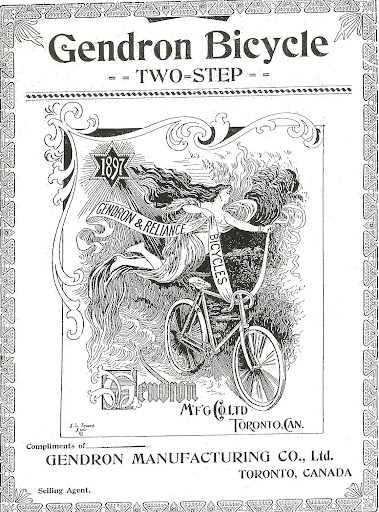
In July 1896 when the Goold Bicycle Co. of Brantford announced that its tandem bicycle had never been beaten in a race, the Gendron company pointed out that the only reason the Goold tandem had never been beaten was that it had never actually been in a race!
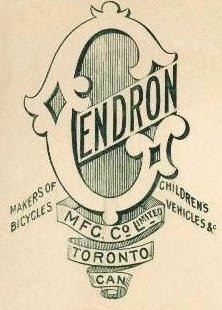
It was a dig that prompted the Brantford company to retort that the Gendron company knew more about “fancy frills and baby-carriage wheels” than it actually did about bicycles, a statement the Gendron folks dismissed as “the most contemptible style of advertisement ever printed in a Toronto paper.” (2)
The barbs continued to fly as the Gendron Mfg. Co. accused the Goold company of producing bicycles with “white-washed” rims, citing the tale of poor Harry Parkin, who, according to the Gendron company, was riding a Goold bicycle out the Kingston Road when the front forks gave out, causing the unfortunate cyclist to suffer “forty-eight hours of unconsciousness, six weeks in hospital, a scar on his face and a heavy bill for repairs.” (3)
The Gendron Mfg. Co. remained a major player in the Canadian bicycle market until the sale of its cycle works to CCM in 1899, following which the company turned its attention to the motor car. By 1920 Gendron had become the world’s largest maker of children’s pedal cars, manufactured to imitate the full-sized automobiles of the day. Sold under the name of Pioneer, the Gendron brand became synonymous with high quality pedal cars that featured cylindrical rear gas tanks, tool boxes, imitation cranks, and nickel trim.

The company stopped making children's vehicles in 1941, but continued to make wheelchairs and other hospital equipment.
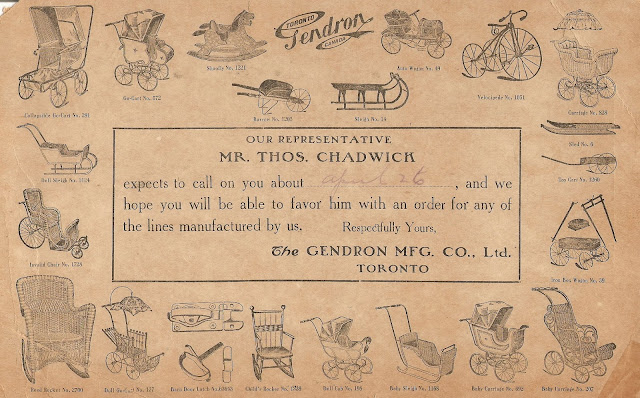
1. Daily Mail & Empire, May 29, 1897
2. "We Beg to Tender Our Hearty Thanks to a Firm Handling Bicycles," The Globe, August 1, 1896
3. ibid.
A Skate Magician
© John McKenty 2012
Born in 1948, I moved with my family to the village of Portsmouth, Ontario, just shortly after it was annexed by the city of Kingston in 1952. It was a union given little attention by the villagers who went about their daily lives as if they were still a recognizable entity unto themselves.
While Portsmouth had the usual small-town amenities such as a corner store (Beckie's), a drug store (Peter's), a barber shop (Ernie's), a hardware (Baiden’s) and a Red & White (Cowan's), it also had an “insane asylum” (Rockwood), as it was known at the time, two rather rowdy hotels (Lakeview Manor & Portsmouth House), as well as two maximum security prisons, one for the men and one for the women. It also had two schools and two churches, one each for the Catholics and the Protestants. Pretty heady stuff for a community of about 500.
With the hotels and prisons standing as a stark reminder of what can happen when one is led astray, it was around this time that local building contractor Harold Harvey, bothered by the frequent sight of children playing in the streets or just hanging out, founded the Church Athletic League, an organization offering recreational hockey, softball, basketball and bowling for young people. The one stipulation was that all participants must attend church or Sunday School 80% of the time. It was Mr. Harvey’s valiant attempt to set the village's and the rest of the city’s youngsters in the right direction.

When the Church Athletic League began its first season of hockey in 1951, it had 100 boys signed up. As the league continued to grow, however, Harvey came up with a plan for a new outdoor rink to be built at the old quarry in Portsmouth, where 19th-century prisoners had once hammered limestone into building blocks. So it was that the Harold Harvey Arena was constructed in 1960 at 42 Church Street, directly across from where I lived at 35 Church St. Over time, my two brothers and I, as well as our dad, would work at the venerable old arena which would begin life as an open-air affair, before eventually being closed in.

Back in those days everyone in Portsmouth brought their skates to Baiden's Hardware to be sharpened. It was a retail operation overseen by Henry Baiden and his younger brother Bill. The problem, according to many in the village, was that Bill knew how to sharpen skates correctly, but Henry didn’t. As a result, before you took your skates in to be done, you peered cautiously around the corner of the store’s front window to ensure that Henry was busy and Bill was not.
 It had long been known that sharpening a skate blade properly was an art form not easily mastered by just anyone, a fact acknowledged by the Toronto Maple Leafs, who for years came to depend upon the team's equipment manager, Tommy Naylor, to keep their blades finely tuned. Naylor’s reputation as a master on the skate machine was such that he would eventually be asked to accompany Team Canada to Europe for the Summit Series in 1972.
It had long been known that sharpening a skate blade properly was an art form not easily mastered by just anyone, a fact acknowledged by the Toronto Maple Leafs, who for years came to depend upon the team's equipment manager, Tommy Naylor, to keep their blades finely tuned. Naylor’s reputation as a master on the skate machine was such that he would eventually be asked to accompany Team Canada to Europe for the Summit Series in 1972.
A summer employee of CCM, Tommy Naylor was born in 1904 and was first employed as a messenger boy for the A.G. Spalding & Bros. Sporting Goods Co. in Toronto. When the regular skate sharpener quit, the company offered the job to Tommy, who, at the time, was also the stick boy for the Toronto Arenas. Tommy took the skate-sharpening job, eventually ending up with the Leafs, where he was variously listed as the team’s assistant trainer or equipment manager.
Among those who praised the way Naylor handled his skates was perennial Leaf all-star King Clancy.
“He never rockered them and I went along with that. Some players liked them that way, but I preferred flat, believing that the more blade you had on the ice, the faster you could go,” said Clancy. (1)

Working in a room under the stairs at the north-east corner of Maple Leaf Gardens, Naylor was sought out by the leading skaters of the day. In 1936 when CCM sent a shipment of skates to Los Angeles for use in her ice show, Sonja Henie, who was notoriously finicky, wanted Naylor to accompany the skates, but he declined.
Henie wasn’t the only famous figure skater to seek out the expertise of Tommy Naylor. Prior to her departure for Europe and world acclaim in 1948, Canada’s sweetheart, Barbara Ann Scott, also paid a visit to Naylor who had been sharpening her skates since she was seven.
Frick and Frack, two comic Swiss skaters, who performed as members of the Ice Follies, seldom appeared in Toronto without looking up Naylor, whom they called the top “skate man” in the world.
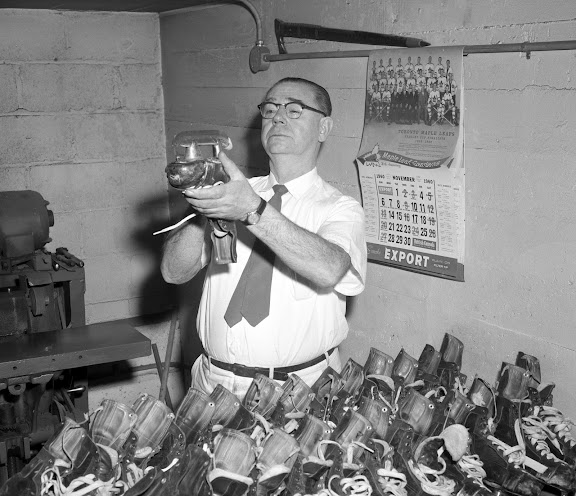
George Hayes, a linesman for twenty years in the NHL, recalled visiting Naylor in his skate room where the walls were covered with old photos, hockey calendars and newspaper clippings.
“He always did a fine job and wouldn’t give them to you if they weren’t just right. He always shellacked the toes of your skate boots and if your laces were a little worn, he’d put in a new pair. Then he’d say, ‘Compliments of the Toronto Maple Leafs,’ but we’d always make him take something a smoke or a beer,” recalled Hayes. (2)
Naylor was such an integral part of the Leaf operation that in 1951 when Conn Smythe, owner of the Leafs, looked at the annual team photo he inquired as to why Tommy Naylor wasn’t in the picture. When told that Naylor hadn’t been asked, Smythe bellowed, “Get the team together with him and take another photo!” (3). From then on, Tommy Naylor was in every official Toronto Maple Leaf photo.
When he wasn’t working on skates Tommy Naylor used his time to try and improve the quality of the equipment being used, including the creation of a trapper glove that goalies could wear. It was following a chance encounter with baseball’s George McQuinn of the Toronto Maple Leafs in the International League that Naylor used the first basemen's glove to come up with a definitive piece of goalie equipment.
“Well I took his old glove and I put a cuff on it and I gave it to Baz Bastien who played goal for the Senior Marlboros.” (4)
The success of the endeavour convinced Naylor to sew a strip of leather in Maple Leaf netminder Turk Broda’s catching glove which up to that time had only had a lace between the thumb and the forefinger. The reworked glove performed so well for Broda that soon goalies throughout the league were looking for one.
When Hap Day of the St. Pats cut his Achilles Tendon in 1926, Naylor used a most unusual item to come up with some protection for the back of Day’s ankles.
“Well I took the stays out of ladies corsets and shaped them down and slid them into nylon pockets, and sewed this into the heel of the hockey boots. These were the first Achilles-tendon guards. I did the same thing on the tongues of Teeder Kennedy’s boots. He was always getting cut on his instep,” explained Naylor. (5)
Naylor used the same principle to add ligament shields to a player’s shin pads and to develop the padded guards most defencemen would end up wearing around their ankles.
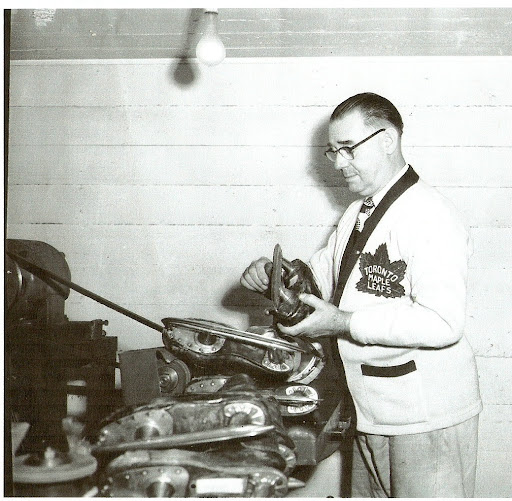


Over the years, despite the ongoing upgrade in equipment, the sharp end of a skate blade remained a constant threat to player safety. Prior to the start of the 1959/60 NHL season, CCM announced that Maple Leaf centre Red Kelly would be wearing a new type of guard on the end of his skate blade. Designed by CCM engineer Bill Shaw, it had been developed in consultation with Tommy Naylor.
The need for such a piece had been intensified when Leaf defenceman Allan Stanley fell in a game against the Montreal Canadiens striking his cheek against the back of Bill Hicke’s skate blade. Stanley came away from the encounter with twenty-five stitches and a broken jaw.
Following the game, Canadiens’ coach Toe Blake suggested that a metal guard connecting the end of the blade to the bottom of the boot should be standard on all skates. Naylor wasn’t so sure.
“There’s no guarantee that’ll prevent injuries. It’s much more important to round that part off when the skate is being sharpened,” maintained the soft-spoken Naylor. (6)
So it was that he and Shaw set about designing and refining the plastic tip which would soon be adopted by all the major skate manufacturers.
There were many who held that if the unassuming Naylor had patented all the inventions he had come up with, he’d have retired a millionaire. But Tommy Naylor didn’t do it for the money and nobody knew that better than Vic Hunt.
A goalie with the Toronto Dukes Jr. B Club, Hunt had been just eighteen years old when his hand was crushed by a press machine at the printing plant where he worked. The doctors had no choice but to amputate eventually fitting Vic with a hook for the stub of his right arm. While Conn Smythe offered to make the lad the Maple Leafs’ stick boy so he could stay involved with hockey, Vic Hunt had a different idea, one that needed the talent of Tommy Naylor.
Working with Hunt, over time Naylor rigged up an attachment that he bolted to the handle of the young man's goalie stick. With the attachment fitting into the hook of his right arm, Vic Hunt used a specially-designed hockey glove to cover the apparatus and to fulfill his dream of returning to the ice. Helping dreams come true was what Tommy Naylor did, but he didn’t do it for the money.
(1) King Clancy and Brian McFarlane, Clancy, (Toronto: ECW Press), 1997, p.95
(2) George Hayes. "Naylor Belonged," Daily Sentinel-Review, Feb 18, 1981
(3) ibid.
(4) Trent Frayne, "Our Memories & Foster Hewitt's Voice Made It Toronto's Most Famous Building," Toronto Star, Oct. 3, 1970
(5) ibid.
(6) Jim Proudfoot, "Skate Guards Could Worsen Injury - Naylor," Toronto Star, Dec. 9, 1960
2012 Canadian Vintage Bicycle Show
Story and photos by Mike Badyk
Reprinted with the kind permission of Canadian Cyclist www.canadiancyclist.com
Many cyclists focus only on the new in the bicycle world, but there are plenty of folks who fondly look back to the history of our beloved sport. A case in point was the 11th Annual Canadian Vintage Bicycle Show taking place on June 24th. The venue was the Heritage View Farm in Brantford, Ontario (and right across the street from the Alexander Graham Bell Homestead). In many respects it is reminiscent of a car show, with manicured lawns and ornamental trees as the backdrop to the various booths.
The show is the passion of Jamie McGregor, who had on display not only a huge collection of vintage bicycles, but also an abundance of 60’s vintage “muscle bikes”. If you’re unfamiliar with the term think of 20” wheeled CCM Mustangs, Raleigh Choppers and Schwinn Stingrays. Jamie doesn’t have a store. “I just collect. I sell some things but it’s not really my focus. It’s important to hang on to all parts of our cycling history.”
Even though there is a commonality of being vintage bikes, there are several sub categories present. The core is the really vintage – bikes over 100 years old. Many of them are Canadian too, showing that we were in the thick of bicycle production. There are a wide variety of balloon tire/cruiser bikes from the 30’s through the 60’s. Then there were the aforementioned muscle bikes from the 60’s, joined by some vintage road racers.

One other category that I have only a little knowledge of is the “Rat Rod Bike”. These are customized bikes based on vintage cruisers. One of the standout bikes at the show was Ken Martin’s CCM Rat Rod. The frame is a 1938 CCM Flyte, which is an Art Deco style absolutely unique to Canada. The paint scheme is based on a 1936 CCM. Besides the saddle from the 30’s, this beauty is a mash up of new parts, new old stock parts and what ever else Ken wanted to do. “I was entering a Rat Rod contest, sort of at the last minute, and I did this bike in just 2 weeks. It is one of those happy accidents where everything just came together. This bike finished 4th in a worldwide competition. I’m really proud of it. So proud that it’s definitely not for sale.” Ken does have some CCM frames and forks for sale though. If you’re interested in this genre of bike visit www.ratrodbikes.com

If you’ve ever seen vintage bikes then you know that many of the modern day innovations were actually tried 100 years ago. There were shaft drive bikes (see the Columbia below), full suspension bikes, racing bikes and utilitarian bikes. Check out this vintage Hartford from 1889. There are so many attempts at innovation on it that it is unbelievable. For all you GoPro users, there is a camera mount on the handlebar.


Some of the cruisers were very pretty. Here are two nice examples; an un-restored Western Flyer and the futuristic Silver King.


If you’ve ever had a desire to get a vintage bike then you’d probably want to try one. There is now a way to do this. A new company called Vintage Velo is about to open in Niagara-on-the-Lake. They have decided to take vintage bikes, restore them, and use them in their rental fleet. This show was their first official event. They have 70’s vintage Schwinns, 60’s CCM’s, and even a couple of 20 year old mountain bikes. They had some really neat bikes that could be just the thing to complete your Niagara visit. The web site is still a work in progress but you can visit them at www.vintage-velo.com


Even though muscle bikes are part of my childhood, my bicycle nostalgia really starts with my first road racing bikes in the late 1960’s. To my surprise I saw an example of my first proper road-racing bike. This is a 1970 Gitane Tour de France. Ah yes. A definite wave of deja vu. I had the same colour too. Sorry I sold it. Like 30 some odd years ago. Good thing this one was too small for me. There's always the danger of coming home with something you didn't intend to at shows like this.

If you’ve never been to the Canadian Vintage Bicycle Show it is well worth the visit. The venue is just gorgeous and the volunteers are super friendly and helpful. The modest admission goes to the Stedman Community Hospice. Check out the event at www.canadianvintagebicycleshow.com I have a sneaking suspicion that this going to become an annual event for my family.
Extra photo – Wilson Tandem – vintage unknown – From Wilson’s Music Store in Sarnia Ontario. Muscle bike display in the background.

MEC Bikefest Toronto
Saturday, June 23, 2012 at the Distillery Historic District
11:00am to 5:30pm

About MEC Bikefest
MEC Bikefest is a daylong community celebration of all things bicycle related. Our goal is to bring together Toronto’s bicycle community and those new to bikes, to celebrate the wonders of cycling. Come join us and make it the best bicycle bash in Toronto.
This free event has something for everyone, so bring the whole family down to the sweetest cycling celebration of the summer.
Workshops and clinics are $5 each with proceeds being donated to our community partner, Cycle Toronto (formerly the Toronto Cyclists Union). Group Rides are free, however registration is required as space is limited. MEC Bikefest happens rain or shine so please dress for the weather. Be prepared for both warm temperatures and rain. Food and snacks will be available for purchase, or you are welcome to bring your own. And don’t forget your water bottle.
Event description
Along with fun and festivities, MEC Bikefest is a hub of knowledge where cyclists new and old can make connections and get the information they need to pursue their passion. Proceeds from this event will be donated to our non-profit partner, the Cycle Toronto.
MEC Bikefest Toronto features activities for cyclists of all skill levels, including:
- Dozens of bike clinics and seminars (presented by MEC, Urbane Cyclist and Hardwood Ski & Bike)
- Bike demos
- Free bicycle safety checks
- Bike valet parking (provided by Cycle Toronto, formerly the Toronto Cyclists Union)
- Free basic repairs and tune-ups (provided by Bike Chain, Bike Pirates, Bike Sauce, Community Bicycle Network and Evergreen Bike Works)
- MEC Bikefest Bike and Gear Swap
- MEC Marketplace
- Local bicycle retailers and exhibitor booths
- Community and cycling advocacy information
- Free drop-in activities for kids
Location
MEC Bikefest Toronto happens downtown in the Distillery Historic District, on Parliament and Mill Street. Ride your bike to the festival – there will be bike valet parking on site. If you are driving, there is ample pay parking available on streets in the area.
SUNDAY, JUNE 24
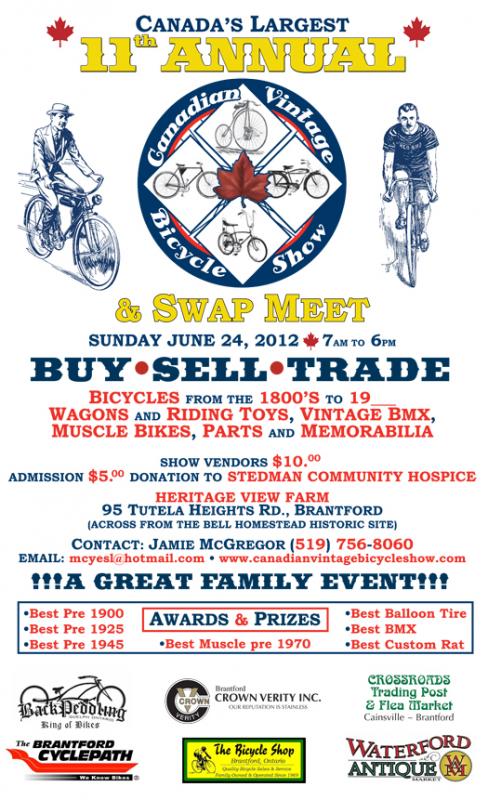

From a few years back:
Record crowd attends Canadian Vintage Bicycle Show
by Heather Ibbotson, Brantford Expositor
Monday, June 28, 2010
 Antique and vintage bicycle fans from across Brant County and beyond were drawn to a farm on Tutela Heights Road on Sunday for the ninth annual Canadian Vintage Bicycle Show.
Antique and vintage bicycle fans from across Brant County and beyond were drawn to a farm on Tutela Heights Road on Sunday for the ninth annual Canadian Vintage Bicycle Show.
Bicycle buff, Ryan O'Brien of Toronto, was one of the early birds and he was impressed by what he saw.
"This is beautiful. I'm surprised at the selection," O'Brien said. "There are some unique pieces."
O'Brien, a member of a Toronto bicycle club called the Devil Strip Rollers, said he enjoys antique bikes and the ingenuity that went into their designs.
"Cycling is so driven by technology these days," he said.
Show organizer Jamie McGregor was confident of a great crowd at this year's event.
"We'll have a record turnout. No doubt," he said shortly after 9 a.m. on Sunday. "I've never seen so many (people) here this early."
More than 50 vendors and their wares dotted the large well-tended property of Jody and Bonnie Varey, who have welcomed the bicycle show to Heritage View Farm for the past five years.
Two-wheeled treasures ranged from those made in the late 1800s to about 1975. "We've got a good range of all eras," McGregor said.
Vendors on the site displayed a huge variety of bicycles, from the so-called "muscle bikes" of the late 1960s and 1970s with their high handlebars and banana seats to the towering Victorian high wheel (or Penny-farthing) with its massive front wheel and tiny rear wheel.
Spare parts were also available in abundance and buyers weren't shy about shelling out the cash. One woman bought a vintage bicycle seat with mammoth springs for $65; another bought a sprocket for $10.

Roger Tupper, of Hamilton, displayed treasures including a 54-inch high wheel made in 1887 by the U.S.-based Columbia bicycle company.
With a leather seat perched atop a huge solid rubber tire, and with only a hand brake to slow down, the high wheel does not look like an easy ride, even if the rider did overcome the hurdle of figuring out how to get on top of it in the first place.
Tupper said high wheel bicycles are not as intimidating to ride as they look. "I got the hang of it pretty quickly," he said.
Still. the contraption is finicky and even hitting a stone can completely send a rider head over heels, he said.
Costing a hefty $100 in their day, high wheels were expensive diversions for the well-heeled. These antique bicycles can now run from $4,500 up to$20,000, Tupper said.
Admittance to the show was a $5 donation to the Stedman Community Hospice. For the past three years, McGregor has used the event to do a bit of fundraising to thank the hospice for the care provided to his father, John, who died there four years ago.
Reprinted with the kind permission of the Brantford Expositor.





